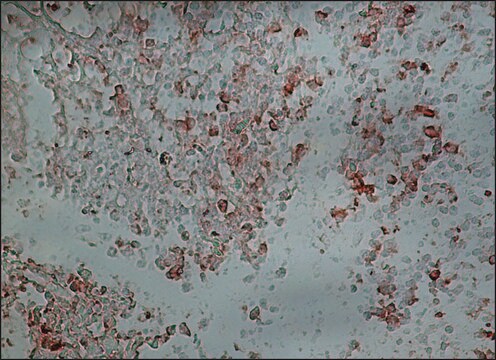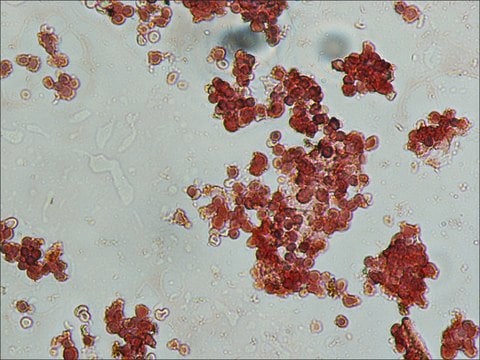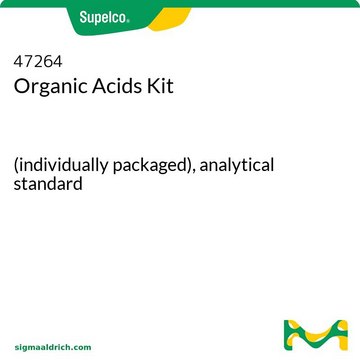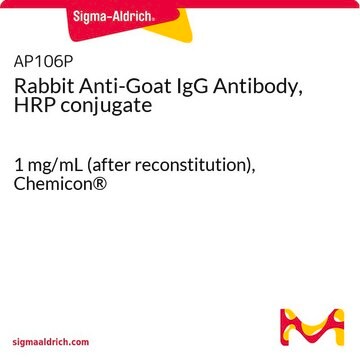A4174
Anti-Goat IgG (whole molecule)–Peroxidase antibody produced in rabbit
affinity isolated antibody, buffered aqueous solution
Synonym(s):
Rabbit Anti-Goat IgG (whole molecule)–HRP
Sign Into View Organizational & Contract Pricing
All Photos(3)
About This Item
Recommended Products
biological source
rabbit
conjugate
peroxidase conjugate
antibody form
affinity isolated antibody
antibody product type
secondary antibodies
clone
polyclonal
form
buffered aqueous solution
species reactivity
goat
should not react with
human
technique(s)
direct ELISA: 1:10,000
shipped in
dry ice
storage temp.
−20°C
target post-translational modification
unmodified
Looking for similar products? Visit Product Comparison Guide
Related Categories
General description
IgG antibodies regulate several functions such as complement activation and phagocytosis. Thus they play a crucial role in facilitating cytological immune responses. Anti-goat IgG (whole molecule)–peroxidase antibody can be used as a secondary antibody in ovarian tissue microarray. Rabbit anti-goat IgG (whole molecule)-peroxidase antibody reacts specifically with all goat IgG but shows no reactivity with human serum proteins.
Immunogen
Purified goat IgG.
Application
Anti-Goat IgG (whole molecule)-Peroxidase antibody produced in rabbit is suitable for use in immunoblot and immunohistochemistry. The product can also be used for direct ELISA (1:10,000).
The presence of pleiotrophin in HUVEC cell culture medium was analyzed by western blot using HRP-conjugated rabbit anti-goat IgGas the secondary at a dilution of 1:7500 in TBST.
Other Notes
Antibody adsorbed with human serum proteins.
Physical form
Solution in 0.01 M phosphate buffered saline, pH 7.4, containing 1% bovine serum albumin and 0.05% MIT.
Preparation Note
Prepared using the periodate method described by Wilson, M.B., and Nakane, P.K., in Immunofluorescence and Related Staining Techniques, Elsevier/North Holland Biomedical Press, Amsterdam, p215 (1978).
Disclaimer
Unless otherwise stated in our catalog or other company documentation accompanying the product(s), our products are intended for research use only and are not to be used for any other purpose, which includes but is not limited to, unauthorized commercial uses, in vitro diagnostic uses, ex vivo or in vivo therapeutic uses or any type of consumption or application to humans or animals.
Not finding the right product?
Try our Product Selector Tool.
Storage Class Code
12 - Non Combustible Liquids
WGK
WGK 2
Choose from one of the most recent versions:
Already Own This Product?
Find documentation for the products that you have recently purchased in the Document Library.
Peter Horak et al.
Clinical cancer research : an official journal of the American Association for Cancer Research, 11(24 Pt 1), 8585-8591 (2005-12-20)
Epithelial ovarian cancer is the most common cause of mortality from gynecologic malignancies. Due to advanced stage at diagnosis, most patients need systemic treatment in addition to surgery. Tumor necrosis factor (TNF)-related apoptosis-inducing ligand (TRAIL) is a member of the
Johan Dixelius et al.
The Journal of biological chemistry, 279(22), 23766-23772 (2004-03-27)
Laminins are widely distributed extracellular matrix proteins. Certain laminin isoforms are predominant in vascular basement membranes and may be critical in maintaining the stability of the mature vessel. On the other hand, formation of new vessels during angiogenesis requires degradation
Harukiyo Kawamura et al.
Blood, 112(9), 3638-3649 (2008-07-31)
Vascular endothelial growth factor (VEGF)-A regulates vascular development and angiogenesis. VEGF isoforms differ in ability to bind coreceptors heparan sulfate (HS) and neuropilin-1 (NRP1). We used VEGF-A165 (which binds HS and NRP1), VEGF-A121 (binds neither HS nor NRP1), and parapoxvirus
Rebekka Mauser et al.
Epigenetics & chromatin, 10(1), 45-45 (2017-09-28)
Histone post-translational modifications (PTMs) play central roles in chromatin-templated processes. Combinations of two or more histone PTMs form unique interfaces for readout and recruitment of chromatin interacting complexes, but the genome-wide mapping of coexisting histone PTMs remains an experimentally difficult task.
Tomasz Klaus et al.
Frontiers in immunology, 9, 1096-1096 (2018-06-08)
Mouse IgG3 is highly protective against several life-threatening bacteria. This isotype is the only one among mouse IgGs that forms non-covalent oligomers, has increased functional affinity to polyvalent antigens, and efficiently agglutinates erythrocytes. IgG3 also triggers the complement cascade. The
Our team of scientists has experience in all areas of research including Life Science, Material Science, Chemical Synthesis, Chromatography, Analytical and many others.
Contact Technical Service








